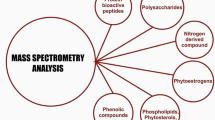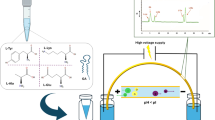Abstract
A liquid chromatography–mass spectrometry (LC–MS) method coupled with specialized sample-preparation strategies was developed to investigate the hydrolysis of ginkgolide B (GB) in physiological environments in comparison with that of ginkgolide A (GA). The rapid hydrolysis processes were captured by the direct injection of samples prepared in the volatile buffers. The LC–MS behavior of the hydrolyzed products, including three monocarboxylates and three dicarboxylates, was acquired. The monocarboxylates were identified by fragmentation analysis, and the dicarboxylates were accordingly tentatively identified by reaction sequences. The base-catalyzed hydrolysis of GB and GA was characterized at 4 °C within pH 7.0–10.7. The regioselective reactions on the lactone-C and lactone-F were revealed by thermodynamic studies at pH 6.8 and 7.4. It was revealed that the 1-hydroxyl group on the skeleton of GB blocks the reactivity of the lactone-E. On the basis of these results, a distinctive hydrolysis phenomenon of GB was confirmed in plasma of humans, rats, and dogs as a rapid degradation of the trilactone along with the only production of the lactone-F-hydrolyzed product. This phenomenon is also closely associated with the 1-hydroxyl group, because it was not observed in GA. More interestingly, the underlying mechanism was revealed not to be associated with any typical enzyme-catalyzed process, but to be potentially involved with a selective reaction of the intact or broken lactone-C moiety with endogenous small-molecule reactants in plasma. This in-depth knowledge of the hydrolysis of GB versus GA not only facilitated understanding of their pharmacological mechanisms but also provided potential routes to study the structure–activity relationships of ginkgolides.

Regioselective hydrolysis of ginkgolide B in pH 7.4 buffers and plasma







Similar content being viewed by others
References
Serajuddin AT, Ranadive SA, Mahoney EM (1991) Relative lipophilicities, solubilities, and structure-pharmacological considerations of 3-hydroxy-3-methylglutaryl-coenzyme A (HMG-CoA) reductase inhibitors pravastatin, lovastatin, mevastatin, and simvastatin. J Pharm Sci 80(9):830–834
Fassberg J, Stella VJ (1992) A kinetic and mechanistic study of the hydrolysis of camptothecin and some analogues. J Pharm Sci 81(7):676–684
Stromgaard K, Nakanishi K (2004) Chemistry and biology of terpene trilactones from Ginkgo biloba. Angew Chem Int Ed Engl 43(13):1640–1658. doi:10.1002/anie.200300601
van Beek TA (2005) Ginkgolides and bilobalide: their physical, chromatographic and spectroscopic properties. Bioorg Med Chem 13(17):5001–5012. doi:10.1016/j.bmc.2005.05.056
Zekri O, Boudeville P, Genay P, Perly B, Braquet P, Jouenne P, Burgot JL (1996) Ionization constants of ginkgolide B in aqueous solution. Anal Chem 68(15):2598–2604. doi:10.1021/ac950939g
Suehiro M, Simpson NR, Underwood MD, Castrillon J, Nakanishi K, van Heertum R (2005) In vivo biodistribution of ginkgolide B, a constituent of Ginkgo biloba, visualized by MicroPET. Planta Med 71(7):622–627. doi:10.1055/s-2005-871267
Ude C, Schubert-Zsilavecz M, Wurglics M (2013) Ginkgo biloba extracts: a review of the pharmacokinetics of the active ingredients. Clin Pharmacokinet 52(9):727–749. doi:10.1007/s40262-013-0074-5
Wang DL, Liang Y, Chen WD, **e L, Wang GJ, Liu XD (2008) Identification of ginkgolide B metabolites in urine and rat liver cytochrome P450 enzymes responsible for their formation in vitro. Acta Pharmacol Sin 29(3):376–384. doi:10.1111/j.1745-7254.2008.00758.x
Wang DL, Peng DY, Tao XH, Cao Y, Chen WD, Liang Y, **e L, Liu XD (2013) The pharmacokinetics and conversion of the lactone to the carboxylate forms of ginkgolide B in rat plasma. J Asian Nat Prod Res 15(4):337–343. doi:10.1080/10286020.2013.764866
Li XJ, Wang YQ, Yang J, Fan X, Wang L, Yang K, Lan K (2015) Semi-quantitative determination of monocarboxylate forms of ginkgolide B in plasma by UPLC-MS. Anal Bioanal Chem. doi:10.1007/s00216-015-8628-z
Liu XG, Qi LW, Fan ZY, Dong X, Guo RZ, Lou FC, Fanali S, Li P, Yang H (2015) Accurate analysis of ginkgolides and their hydrolyzed metabolites by analytical supercritical fluid chromatography hybrid tandem mass spectrometry. J Chromatogr A 1388:251–258. doi:10.1016/j.chroma.2015.02.031
Andersen NH, Christensen NJ, Lassen PR, Freedman TB, Nafie LA, Stromgaard K, Hemmingsen L (2010) Structure and absolute configuration of ginkgolide B characterized by IR- and VCD spectroscopy. Chirality 22(2):217–223. doi:10.1002/chir.20730
Psychogios N, Hau DD, Peng J, Guo AC, Mandal R, Bouatra S, Sinelnikov I, Krishnamurthy R, Eisner R, Gautam B, Young N, **a J, Knox C, Dong E, Huang P, Hollander Z, Pedersen TL, Smith SR, Bamforth F, Greiner R, McManus B, Newman JW, Goodfriend T, Wishart DS (2011) The human serum metabolome. PLoS One 6(2), e16957. doi:10.1371/journal.pone.0016957
Jensen AA, Begum N, Vogensen SB, Knapp KM, Gundertofte K, Dzyuba SV, Ishii H, Nakanishi K, Kristiansen U, Stromgaard K (2007) Probing the pharmacophore of ginkgolides as glycine receptor antagonists. J Med Chem 50(7):1610–1617. doi:10.1021/jm070003n
Braquet P (1988) Ginkgolides: chemistry, biology, pharmacology and clinical perspectives. J. R Prous Science Publishers, Barcelona
Lv H, Wang G, Wu X, **e L, Huang C, Li H, Liang Y, Hao H, Sun J (2008) Transport characteristics of ginkgolide B by Caco-2 cells and examination of ginkgolide B oral absorption potential using rat in situ intestinal loop method. Int J Pharm 351(1–2):31–35. doi:10.1016/j.ijpharm.2007.09.026
Acknowledgement
We are grateful for financial support from the NSFC (81302844). We thank Professor M.Z. Liang at West China Hospital (Sichuan University) for gifting human plasma from healthy volunteers.
Declaration on conflict of interest
The authors declare that there are no conflicts of interest.
Author information
Authors and Affiliations
Corresponding author
Electronic supplementary material
Below is the link to the electronic supplementary material.
ESM 1
(PDF 2856 kb)
Rights and permissions
About this article
Cite this article
Li, XJ., Yang, K., Du, G. et al. Understanding the regioselective hydrolysis of ginkgolide B under physiological environment based on generation, detection, identification, and semi-quantification of the hydrolyzed products. Anal Bioanal Chem 407, 7945–7956 (2015). https://doi.org/10.1007/s00216-015-8963-0
Received:
Revised:
Accepted:
Published:
Issue Date:
DOI: https://doi.org/10.1007/s00216-015-8963-0




